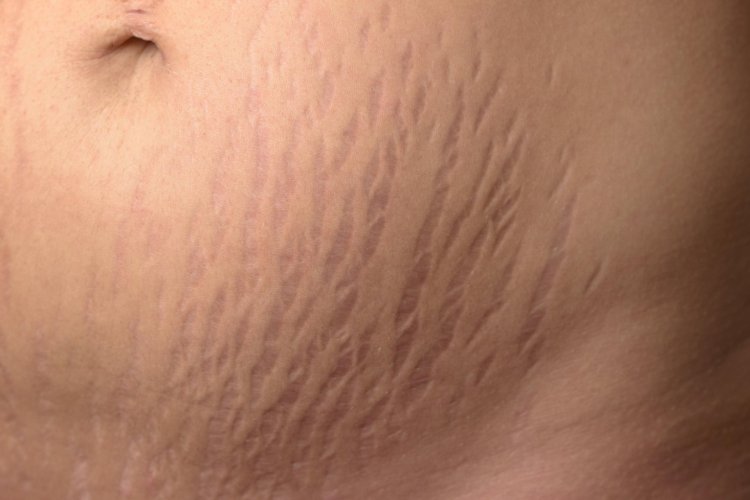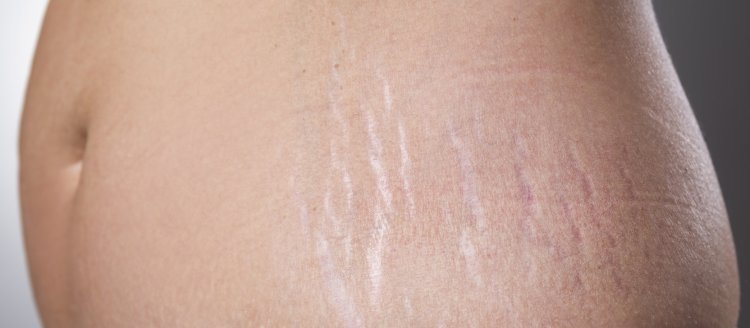Stretch Marks During and After Pregnancy
Stretch Marks During and After Pregnancy

Pregnancy brings about a myriad of changes in a woman's body, including some pleasurable transformations such as flawless and glowing skin, beautiful hair, and an overall positive outlook on life. However, alongside these positive changes, there are also a few common and, at times, annoying signs that accompany the journey of pregnancy. One of these common occurrences is the development of stretch marks, which are prevalent during and after pregnancy. Approximately 7 out of 10 pregnancies result in the formation of stretch marks.
Most commonly, stretch marks make their appearance in the third trimester of pregnancy, manifesting as purple or pinkish streaks primarily on the belly. While the belly is the most common location, these marks can also be found on the breasts, thighs, and hips. Although many stretch marks tend to fade on their own within a few months after delivery, transitioning into pale white streaks, some women may notice that they persist in this matured form.
These marks, though often considered a natural part of the pregnancy journey, can be a source of concern for some women. However, it's essential to recognize that stretch marks are a common and normal aspect of pregnancy, and various creams and oils are available that may help reduce their appearance or alleviate itching. Ultimately, each woman's experience with stretch marks is unique, and while they may be an unwelcome change, they are a testament to the incredible journey of bringing new life into the world.
What causes stretch marks during pregnancy?
Stretch marks, characterized by wrinkly and raised lines, typically make their appearance on areas such as the belly, breasts, and back. These marks develop due to the skin undergoing significant stretching, primarily as the abdomen expands to accommodate the growing baby during pregnancy. The process of stretch mark formation is closely tied to the natural softening of the belly and pelvic muscles, which occurs to facilitate the childbirth process.
Despite the skin's inherent elasticity, stretch marks emerge when there is an excessive and rapid stretching of the skin, often associated with quick weight gain during pregnancy. The skin comprises three layers, with the middle layer known as the dermis containing collagen bundles. During periods of extensive stretching, these collagen bundles in the dermis can become disrupted, leading to the formation of scar-like signs – the stretch marks. The appearance of these marks is a common phenomenon during pregnancy, as the body undergoes remarkable changes to accommodate the developing fetus. While stretch marks are a natural occurrence and vary in appearance among individuals, there are various products and treatments available that aim to minimize their visibility and promote skin health during and after pregnancy.
Do all pregnant women get stretch marks?
Indeed, stretch marks are a common occurrence during pregnancy, affecting a significant percentage of women. Statistics suggest that approximately 70 to 80 percent of pregnant women may develop stretch marks, typically appearing during the sixth or seventh month of pregnancy. The likelihood of experiencing stretch marks varies among individuals and is influenced by factors such as the elasticity of the skin. While some women may not develop noticeable stretch marks, others may find them forming as the skin undergoes significant stretching to accommodate the growing baby. Genetics, weight gain during pregnancy, and skin type are among the factors that contribute to the likelihood and severity of stretch marks. While these marks are a natural part of the body's adaptation to pregnancy, their appearance and impact can differ widely from woman to woman.
Getting rid of stretch marks
Indeed, treating stretch marks is often most effective when they are still in their early stages, typically appearing as reddish or pinkish lines. At this point, the marks are considered "new" or in the process of formation. During this phase, the stretch marks are more responsive to various treatment options, and there's a higher chance of improving their appearance.
Once stretch marks mature and fade to a white or silver color, they enter a phase where they are considered older or "matured." At this stage, it becomes more challenging to treat them effectively. The underlying collagen and elastin fibers in the skin have undergone changes during the initial stretching, and the marks may become less responsive to interventions.
While it might be more difficult to completely eliminate matured stretch marks, some treatments and products may still help improve their texture, reduce redness, and enhance overall skin appearance. Common treatments for stretch marks include topical creams, oils, laser therapy, and microdermabrasion. It's important to note that individual responses to treatments vary, and what works for one person may not have the same effect for another.
Prevention is also a key aspect of managing stretch marks. Keeping the skin well-hydrated, maintaining a healthy weight during pregnancy, and incorporating a balanced diet with nutrients that support skin health are essential practices. Consulting with a healthcare professional or dermatologist can provide personalized advice on the most suitable treatment options based on individual circumstances.
Preventing Stretch Marks During Pregnancy

What's Your Reaction?














